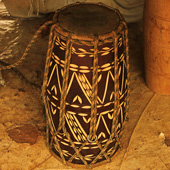Dholak Waale - Thanisandra
The people carries and play with the dholak or dhol, goes around the streets of Bengaluru making different sounds from dholaks with the rhythm of high and low pitches where the people are referred to as Dholakwaale or dholakwalas. These people go around playing and cheering the children around there by the children force their parents in buying one for them to spend their time drumming around and playing with during vacations. Dholakwaale’s live in tents with their families in the Thanisandra region of Bengaluru, Karnataka. It is believed that these people came to Bengaluru 20 years back and from then keep wandering from region to region in the city selling the dholaks. It is believed that the dholakwaale originate from the Fatehpur, Barabanki district of Uttar Pradesh state of India. They usually belong to the Usmani community who earlier was distinctively known for the dholaks made from the wood. Mango, Teak or Jackfruit wood is preferred for the dholak, purchased from Moradabad. Rest of the materials is gathered from neighboring places of their village. As per the artisan they make and sell the cardboard dholak more in the summer season (Month of March, April and May).
Membrane of dholaks are the leather (skins of animal) covered on the two ends of the cardboard cylindrical rolls by giving a resonating chamber for the resulting sound. The leather usually preferred for the dholaks are usually made up of goat which is tanned and purchased from Kanpur region of Maharashtra. If the leathers are not in good condition it is washed, dried under direct sunlight and utilized further. This type of dholak is usually made for the children to play around which is said to be developed from the wood dholak which was actually prepared previously. Nowadays these people prepare the dholak with wood only on the requirement of the customer.









